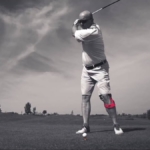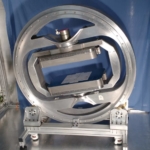Gait can determine source of knee OA
A small study published in the journal Arthritis Care & Research shows that patients with post-traumatic knee osteoarthritis have a decreased adduction as compared to patients with non-traumatic knee osteoarthritis.

Evoke™ knee brace highlights. OssKin
Significance and Innovations
Source Arthritis Care & Research |
By Amy Reyes, Rheumatology Network September 14, 2016
While knee osteoarthritis (OA) affects 16% of adults who are 45 years and older, knee OA is different for patients whose injury is as a result of trauma, as compared to those who report having no injury to the knee. The two sources of injury are biologically and radiographically different. Non-traumatic knee OA is marked by joint space narrowing and osteophytes predominantly in the medial compartment.
In post-traumatic knee OA, changes within the medial and lateral compartments of the joint tend to be evenly distributed. These changes include increased meniscal derangement and bone marrow lesion in the lateral knee compartment. In addition, post-traumatic knee OA is associated with decreased synovial fluid and an increased synovial fluid antioxidant enzyme.
The new study shows that frontal plane knee kinematics and kinetics are expressed differently during walking tests for these two groups of patients — who suffered from medial compartment knee OA.
“These differences in gait biomechanics should be considered when investigating biomechanical risk factors and intervention strategies,” wrote the study’s authors who were led by Shawn M. Robbins PhD of McGill University, Montreal.
The study included 122 patients with non-traumatic knee OA and 93 post-traumatic knee OA. The non-traumatic OA group had higher adduction angles and moments. This group was a significant predictor of peak knee adduction angles (P = 0.04) and moments (P = 0.05), even after controlling for age, speed and disease severity. Similarly, it was a significant predictor for some knee adduction angle (P = 0.02 to 0.64) and moment (P = 0.02 to 0.25) PC scores.
The study’s authors noted some limitations, including having few women (25%) in the study, not controlling for pain medication and the post-traumatic knee OA classification included patients with concomitant injuries or a history of reconstructive surgery.
“Although longitudinal studies are required, these findings are consistent with the suggestion that both static and dynamic alignment contribute to the development of medial knee OA differently in these subgroups, and they may benefit from different biomechanical intervention strategies,” the authors wrote.
Source Rheumatology Network
| Further reading |
acr22822
Comparison of Gait Characteristics Between Patients With Nontraumatic and Posttraumatic Medial Knee Osteoarthritis, Robbins SM, Birmingham TB, Jones IC, Sischek EL, Dietzsch M, Giffin JR. Arthritis Care Res (Hoboken). 2016 Sep;68(9):1215-23. doi: 10.1002/acr.22822. Epub 2016 Jul 27.
Immediate Effects of a Brace on Gait Biomechanics for Predominant Lateral Knee Osteoarthritis and Valgus Malalignment After Anterior Cruciate Ligament Reconstruction, Hart HF, Collins NJ, Ackland DC, Cowan SM, Hunt MA, Crossley KM. Am J Sports Med. 2016 Apr;44(4):865-73. doi: 10.1177/0363546515624677. Epub 2016 Feb 3
Also see
Arthritis Can Cause Gait Abnormalities, An Overview of Arthritis Very Well
Feedback-based rehab could lower risk of OA Lower Extremity Review






